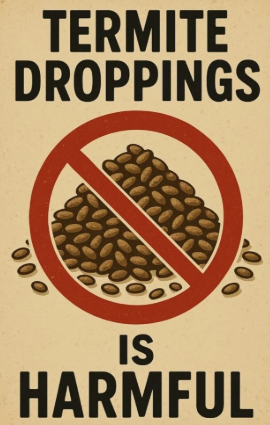Termites are often referred to as “silent destroyers” because they can cause significant damage to homes and properties long before any visible signs emerge. One of the earliest and most overlooked indicators of termite presence is termite droppings, also known as frass. While these tiny pellets may seem harmless at first glance, they are a red flag for a hidden infestation lurking behind your walls or beneath your floors.
At Detect Termite, we specialize in identifying these early signs before they escalate into costly repairs. Understanding termite droppings is crucial for every homeowner who wants to safeguard their property from this destructive pest.
What Are Termite Droppings?
Termite droppings, or frass, are small, wood-colored pellets that termites expel as they tunnel through wood. Unlike other pests, termites maintain clean and organized tunnels. They remove their waste to keep their nests clean, pushing frass out through small holes in wood, drywall, or other infested materials.
Drywood termites, in particular, are known for producing frass. Subterranean termites do not leave visible droppings in the same way because they use their feces to build mud tubes and nests. The appearance of these dry, granular droppings is often one of the few outward signs that drywood termites are present.
Characteristics of Termite Droppings
Size: About 1 mm in length
Shape: Oval with six concave sides
Color: Varies from light beige to dark brown, depending on the type of wood consumed
Texture: Dry and sand-like
These droppings are often found in small piles near baseboards, windowsills, or under wooden furniture.
Why Are Termite Droppings a Concern?
Many homeowners may sweep away the droppings without a second thought. However, doing so without further inspection can allow the problem to worsen over time. Termite droppings are not just debris—they’re a clear message from the pests infesting your property.
Here’s why termite droppings should never be ignored:
Hidden Damage: Droppings indicate active termite activity inside your walls or furniture.
Structural Risk: If left untreated, termites can hollow out beams and floorboards, compromising the structural integrity of your home.
Recurring Infestations: Simply cleaning the droppings doesn’t remove the termites. Professional help is needed to eliminate the colony.
Health Concerns: While termite droppings are not toxic, accumulated frass can cause allergic reactions in some individuals, especially when disturbed.
Common Areas Where Termite Droppings Are Found
Being vigilant and knowing where to look can help you detect an infestation early. Here are some of the most common places where termite droppings may be found:
Windowsills and door frames
Under wooden furniture
Near baseboards or crown moldings
Inside cabinets or closets
Around attic beams or crawl spaces
Under floorboards and carpets
At Detect Termite, our inspections are thorough and focused on these high-risk areas to ensure no warning sign is overlooked.
Termite Droppings vs. Sawdust: How to Tell the Difference
One common mistake is confusing termite frass with sawdust. While they might look similar at a glance, there are key differences that can help you distinguish between the two.
Termite Droppings:
Uniform in size and shape
Pellet-like with ridges
May be found in small, neat piles
Indicates an active termite infestation
Sawdust:
Irregular in size and shape
Loose and fluffy in texture
Usually found near active woodworking areas
Doesn’t suggest pest activity unless combined with other signs
When in doubt, contact Detect Termite for a professional inspection. Our team can quickly determine whether you’re dealing with an infestation or simply residue from woodworking.
What to Do If You Find Termite Droppings
Finding termite droppings should immediately raise concern. Here’s what you should do if you spot them:
Do Not Disturb the Area
While it might be tempting to clean up the droppings right away, avoid disturbing the area too much. This can make it harder for professionals to locate entry points or track the extent of the infestation.
Document the Evidence
Take clear photos of the droppings and note their location. This can help the pest control team assess the situation more accurately and develop a targeted treatment plan.
Schedule a Professional Inspection
The next step is to call Detect Termite for a thorough inspection. Our trained technicians use advanced tools and techniques to find the source of the infestation, assess the level of damage, and propose a tailored solution.
Avoid DIY Treatments
Over-the-counter sprays and baits may kill a few termites, but they won’t eliminate the colony. DIY methods can also spread the termites deeper into your home, making them harder to remove later. Trust the professionals to get the job done right.
How Detect Termite Can Help
At Detect Termite, we pride ourselves on early detection and precise elimination of termite colonies. When you contact us, here’s what you can expect:
Free Visual Inspections: We offer no-obligation inspections to determine the presence and extent of termite activity.
Customized Treatment Plans: Depending on the type and severity of infestation, we recommend a plan tailored to your home.
Eco-Friendly Solutions: Our treatments are effective yet safe for families and pets.
Preventative Measures: We don’t just eliminate termites—we help you prevent future infestations with long-term solutions and education.
Ongoing Monitoring: With scheduled visits and inspections, we ensure that termites don’t return.
Final Thoughts:
Termite droppings may be small, but they speak volumes. They are one of the most telling signs of a drywood termite infestation and should never be ignored. With early detection and professional help from Detect Termite, you can stop the damage before it escalates and ensure your home remains safe, sound, and pest-free.
 :
https://www.pinterest.com/
:
https://www.pinterest.com/

